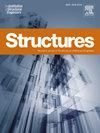回顾预制和体积采矿结构:目前的做法,挑战和未来的前景
IF 4.3
2区 工程技术
Q1 ENGINEERING, CIVIL
引用次数: 0
摘要
预制建筑在住宅、商业和工业领域继续受到欢迎。预制技术从非体积装配发展到体积构造。虽然体量建筑通过提供更安全、确定和可持续的施工方法来降低项目风险,但它也不是没有挑战,特别是将超大体量结构运输到澳大利亚偏远地区的能力。它还没有被接受为一种主流的建筑实践。虽然体积结构的演变仍然是一个令人感兴趣的来源,但需要更多关于采矿部门结构体积结构的文献。本文回顾了工业中使用的各种术语,并为包括采矿业在内的工业参与者提出了统一的术语。该审查考虑了预制结构在澳大利亚偏远地区的安全性、生产率、质量进度、成本和可持续性方面的好处。从规划、海上运输和公路运输的角度审查了所面临的挑战。本文最后提出了一种替代方案,以克服需要考虑的挑战和施工要求。本文章由计算机程序翻译,如有差异,请以英文原文为准。
Review of prefabrication and volumetric mining structures: Current practice, challenges, and future prospects
Prefabricated construction continues to gain popularity in the residential, commercial, and industrial sectors. Prefabrication developed into non-volumetric assembly and then into volumetric construction. Whilst volumetric construction reduces project risk by providing a safer, certain, and sustainable construction approach, it is not without its challenges, specifically the ability to transport oversized volumetric structures to remote Australian locations. It is yet to be accepted as a mainstream construction practice. While the evolution of volumetric construction continues to be a source of interest, more literature on structural volumetric construction within the mining sector is desired. This paper reviews various terminology used in industry and suggests unified terminology for industry participants, including those in the mining sector. The review considers the benefits of prefabricated structures at remote locations in Australia in terms of safety, productivity, quality schedule, cost and sustainability. The perceived challenges are reviewed in terms of planning, sea transportation and road transportation. The paper concludes by proposing an alternative to overcome the challenges and the construction requirements that require consideration.
求助全文
通过发布文献求助,成功后即可免费获取论文全文。
去求助
来源期刊

Structures
Engineering-Architecture
CiteScore
5.70
自引率
17.10%
发文量
1187
期刊介绍:
Structures aims to publish internationally-leading research across the full breadth of structural engineering. Papers for Structures are particularly welcome in which high-quality research will benefit from wide readership of academics and practitioners such that not only high citation rates but also tangible industrial-related pathways to impact are achieved.
 求助内容:
求助内容: 应助结果提醒方式:
应助结果提醒方式:


